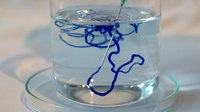
Photo from wikipedia
Circularity of cellulose-based pre- and post-consumer wastes requires an integrated approach which has to consider the characteristics of the fibre polymer and the presence of dyes and additives from textile… Click to show full abstract
Circularity of cellulose-based pre- and post-consumer wastes requires an integrated approach which has to consider the characteristics of the fibre polymer and the presence of dyes and additives from textile chemical processing as well. Fibre-to-fibre recycling is a condition to avoid downcycling of recycled material. For cellulose fibres regeneration via production of regenerated cellulose fibres is the most promising approach. Textile wastes contain dyes and additives, thus a recycling technique has to be robust enough to process such material. In an ideal case the reuse of colorants can be achieved as well. At present nearly 80% of the regenerated cellulose fibre production utilises the viscose process, therefore this technique was chosen to investigate the recycling of dyed material including the reuse of the colorant. In this work, for the first time, a compilation of all required process steps to a complete circular concept is presented and discussed as a model. Indigo-dyed viscose fibres were used as a model to study cellulose recycling via production of regenerated cellulose fibres to avoid downcycling. Indigo was found compatible to the alkalisation and xanthogenation steps in the viscose process and blue coloured cellulose regenerates were recovered from indigo-dyed cellulose. A supplemental addition of reduced indigo to the cellulose solution was also found feasible to adjust colour depth in the regenerated cellulose to the level required for use as warp material in denim production. By combination of fibre recycling and indigo dyeing the conventional yarn dyeing in denim production can be omitted. Model calculations for the savings in water and chemical consumption demonstrate the potential of the process. The proportion of the substitution will depend on the collection rate of denim wastes and on the efficiency of the fibre regeneration process. Estimates indicate that a substitution of more than 70% of the cotton fibres by regenerated cellulose fibres could be achieved when 80% of the pre- and post-consumer denim wastes are collected. Therefore, the introduction of fibre recycling via regenerated cellulose fibres will also make a substantial impact on the cotton consumption for jeans production.
Journal Title: Polymers
Year Published: 2022
Link to full text (if available)
Share on Social Media: Sign Up to like & get
recommendations!